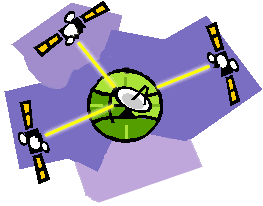| Frequently Asked Questions
about GPS Background
GPS (Global Positioning System) is a satellite navigation system to determine
accurate location and time. It was developed by the U.S. Department of
Defense, and is widely used today for both navigation and time
synchronization. The satellites are owned by the Department of Defense,
paid for by U.S. tax dollars, and reception of satellite signals is available
for public use. More on GPS technology... |
 |
ClockWatch Star Sync GPS time synchronization
works by using a GPS receiver that is connected to your computer.
Beagle Software has designed a software interface to turn your computer into a
network time source.Here are some frequently asked questions
about GPS.
Feel free to with other
questions you have.
|
How does Star Sync get
the time from GPS ?
What type of GPS
receiver works best?
How accurate is GPS time synchronization?
How does GPS work?
Where does GPS work?
Understanding GPS
technology...
What type of hardware do I need?
Do I need an Internet connection to use GPS?
I already have a GPS receiver; will ClockWatch Star Sync
work with it?
Why would I want to use GPS?
Can other computers and devices get their time from Star Sync?
How does Star Sync get
the time from the GPS?
The GPS receiver outputs UTC (Coordinated Universal Time) date and time of day
in the transmitted data. After the initial position fix, the date and time of
day are calculated using GPS satellite information and are synchronized with the
one-pulse-per-second output.
The highly accurate one-pulse-per second output
is provided to Star Sync from the Garmin GPS35. The signal is generated after
the initial position fix has been calculated and continues until power down.
This rising edge of the signal is synchronized to the the start of each GPS
second. The information transmitted to Star Sync is referenced to the pulse
immediately preceding the NMEA 0183 RMC sentence. Beagle Software specially
configures the Garmin GPS35 so that this pulse is usable by the Star Sync
software.
What type of GPS receiver
works best?
Some GPS receivers work better for receiving time signals. This is due to
the default port used for time, which is considered by navigational receivers to
be a secondary priority. You will have more accurate time if you use a
receiver that has PPS (pulse per second) output available, and that this output
is the priority.
Beagle Software offers the Garmin GPS35
receiver, which is specifically designed for time output.
How Does GPS
work?
 GPS receivers integrate a radio and a navigation
computer and can receive the faint, twenty-watt signals coming from the
satellites. The computer uses these signals to calculate the distance between
the satellites and the receiver. With this information, the computer can further
calculate the position and velocity of the receiver. GPS receivers integrate a radio and a navigation
computer and can receive the faint, twenty-watt signals coming from the
satellites. The computer uses these signals to calculate the distance between
the satellites and the receiver. With this information, the computer can further
calculate the position and velocity of the receiver.
The number of satellites visible to a receiver constantly varies between four
and eleven according to time and location. Each satellite broadcasts a number of
unique spread-spectrum codes, but only one, the Coarse Acquisition (C/A) code,
is easily accessible for civilian use. The C/A in orbit 11,000 miles above
earth, GPS satellites transmit at twenty watts a number of unique
spread-spectrum code. The number of satellites visible to a GPS receiver
constantly varies between four and eleven according to time and location. Code
is effectively a timing signal synchronized to an international time
standard-Universal Coordinated Time (UCT). UCT is kept by a world-wide ensemble
of cesium and hydrogen maser frequency standard atomic docks. The
highest-quality GPS receivers measure the C/A code to better-than- nanosecond
precision. More...
How accurate is GPS
time synchronization?
GPS time synchronization is highly accurate, but your results will vary
depending on your receiver and computer. The Garmin GPS35 receiver is
accurate to within a millisecond of UTC; however, the time that is ultimately
synchronized to your computer will not be as accurate. Why? Because
computer systems are not fast enough nor consistent enough for better
accuracy. Our tests show an accuracy of +/- 0.1 second using the Garmin
GPS35.
Where can GPS work?
GPS reception is available around the globe. You will need to have a clear
view of the skies so the receiver can triangulate at least three
satellites. An office window works well, but you may have problems
receiving signals in the inner area of buildings. In general, metal and masonry
block GPS signals, while glass, wood, or plastic does not.
Under specific conditions, GPS will not provide
the time. For instance, the 1,542 MHz GPS signal does not penetrate buildings,
which makes it difficult to receive signals indoors away from windows. Also the
signal can be critically weakened by heavy foliage and interfered with by other
sources such as poorly maintained television broadcasting equipment.
What type of hardware do
I need?
You need a GPS receiver, antenna, power supply, data cable and serial port
connector. These
come standard with the Garmin GPS35. You also need access to a power
source. You may also purchase accessories, including mounting units from
Beagle Software.
The only other requirement is a functioning
Windows PC
with an available serial (COM) port.
Do I need an Internet
connection to use GPS?
No. GPS time synchronization does not require an Internet connection.
I already have a GPS
receiver; will ClockWatch Star Sync work with it?
ClockWatch Star Sync will work with most GPS receivers with
NMEA 0183 data output connected to an available serial port on the computer
running Star Sync software.
Why would I want to use GPS for time synchronization?
Time syncing using GPS is a good alternative for remote or highly secured
computers. ClockWatch Star Sync does not require an Internet or modem
connection.
GPS time synchronization may potentially be more accurate than syncing over
the Internet or by modem. The true accuracy depends on the receiver as
well as the computer. Beagle Software's experience is that the Star Sync
when used with the supplied Garmin
GPS35 receiver is consistently accurate within 0.1 second.
Can
other computers and devices get their time from Star Sync?
Yes, computers, routers, printers, PBXs and other devices on your LAN can use
Star Sync as a central timeserver. All they need to do run an NTP or SNTP client
and point to the computer running Star Sync. Many computers (including Windows)
and networked devices have this capability built in.
Back to top
For more information:
Advanced Features
or Star Sync software
Star Sync GPS Receivers:
Installation Information
Antenna Mounting Options
Frequently Asked Questions about GPS
GPS Glossary
Star Sync Main Page
Star Sync Site Index
| 

